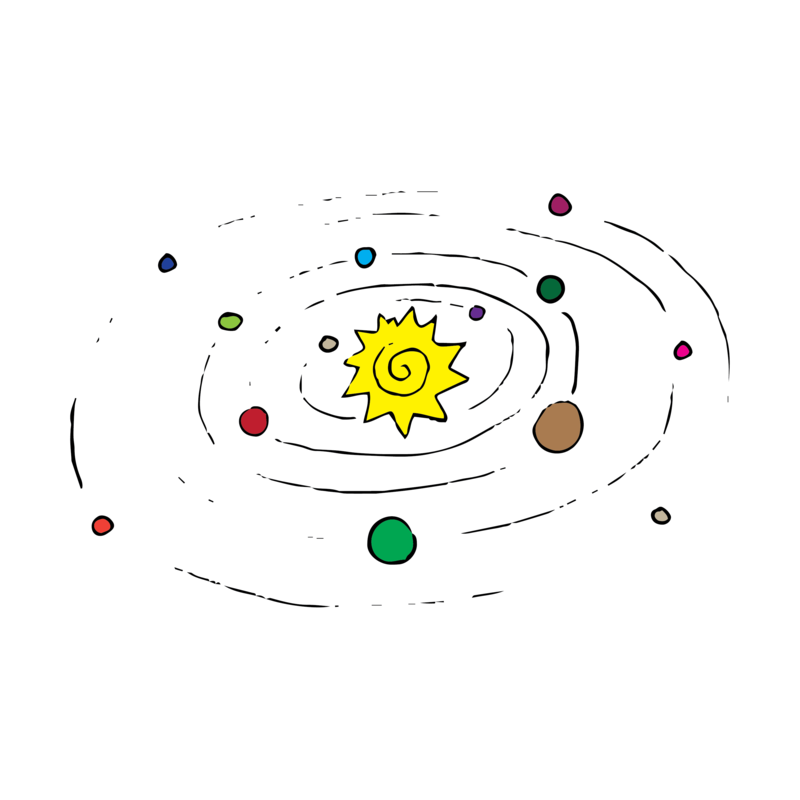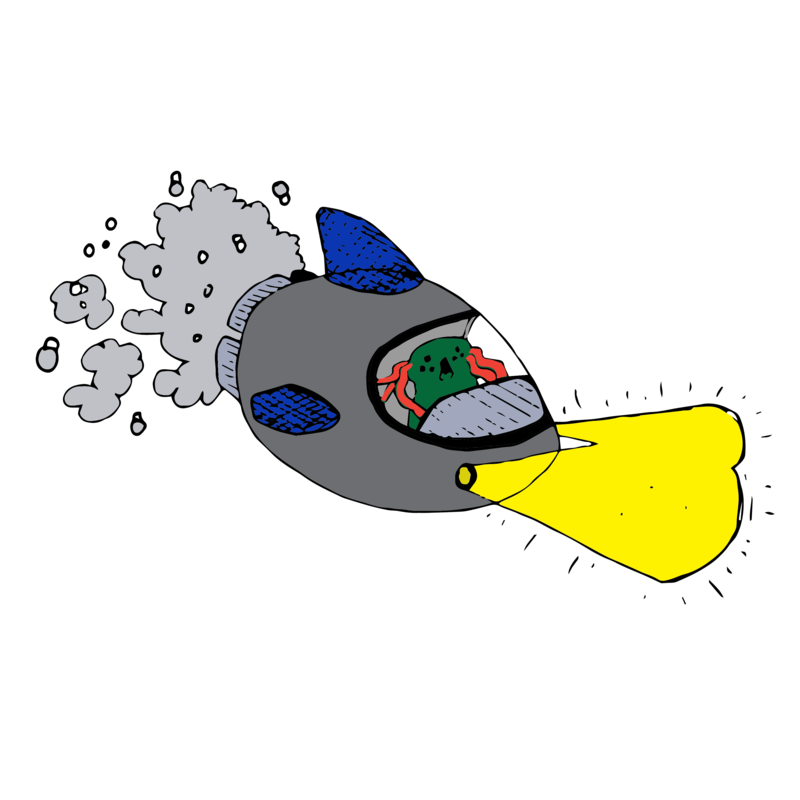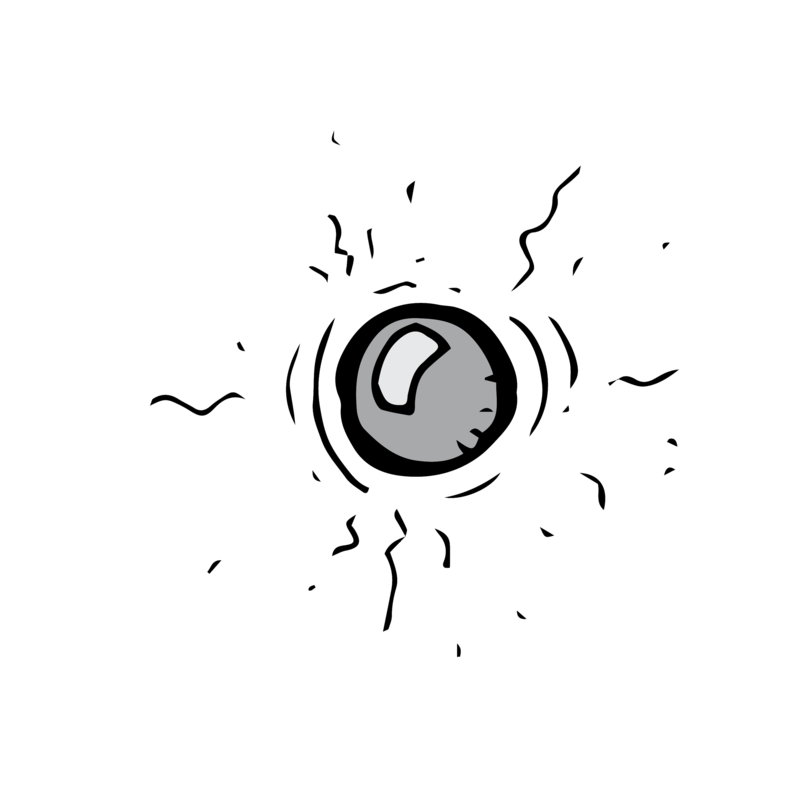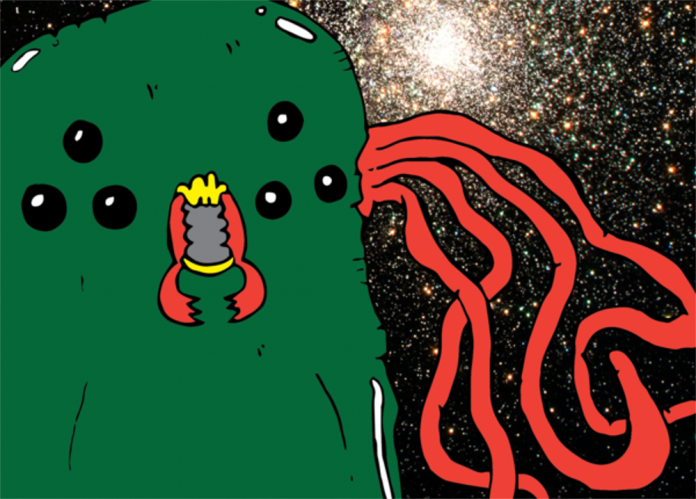The planet was a darkened blue dot. There were no other celestial bodies nearby to give off or reflect light, save for one ancient red giant, millions of miles from the planet’s surface. It spun quietly in the formless void. To those who exist within it, the planet was called Kathexis.
At the surface, waves crashed beneath a thin veil of atmospheric clouds. Dark liquid churned to a froth as the waves jump; this planet was devoid of land, and the sea was vast, deep, and unending. The atmosphere sat extremely close to the sea, therefore no airborne life had ever developed. Beneath the roiling whitecaps and swells, there existed a boundless fountain of life. Thousands upon thousands of creatures, endlessly adrift in the all-encompassing ocean of Kathexis.
Kathexis had once been one of 13 planets in this solar system. Each of the planets had its own unique and extreme climates. This system functioned in orbital harmony for billions of years, with Kathexis being the furthest from the central star of the solar system.
Around 10.4 billion years ago, this solar system was met with great disaster. The already complex and interwoven orbits of the 13 planets became increasingly imbalanced as they began to amass huge numbers of smaller orbiting objects and satellite moons. This led to the rotation of orbits becoming exponentially more erratic until, eventually, the magnetic fields of two planets rebounded off of one another, throwing huge rocks into nearby planets. This resulted in further planetary chaos, coming to a final head when 12 of the planets, in a tight-knit, clustered rotation of spheres about 50 million miles from the sun, began to fuse together and build pressure inside. The immense pressure and heat generated at the core of this grouping eventually built up an extremely dense mass and imploded, forming a black hole.
The black hole then reeled in the remaining two objects: Kathexis, and the sun. As they hit the event horizon, they began to warp, stretching into eggs which dissolved and whirled into infinite fractals until it was all just muddy darkness.
You may think this destroyed or otherwise brought an end to the system quite neatly, but what resulted from the sun and Kathexis entering into the black hole was actually an amazing fusion of energies. Over time, as the black hole moved through space, it began showing signs of development. Instead of increasing in density and absorbing nearby matter, it actually began to exhibit a more gaseous and light-emitting form. The now roughly spherical object had come to rest in orbit around a new star. Kathexis had been reborn, reforged, and fused with its previous sun, the black hole serving as the forge of their union.
Kathexis was now, after eons of change and evolution, 80 per cent liquid, five per cent atmosphere, 15 per cent land, and a home for countless beings, though none as central as those at its core. Beings who had developed cognitively ahead of their neighbouring species, and built a city at the planet’s core; they took up the name of the Kathexi, or Kathexians. Strange bulbous sac creatures they were, propped up on tight-packed groupings of tentacles which they used to move about, whether on land or in liquid. Six lidless black eyes sat in triad clusters on either side of small clicking mandibles, viewing the world in their own unique spectrum of light. And, sprouting out from their head sacs on each side, were four lengthy flagellum with little wiggling noodle appendages at their tips, to grip and touch.
These creatures lived a life of relative ease compared to the constant life or death struggle in the deeps, for they had claimed the only dry land in the entire planet: the core. From there, they launched all sorts of inquisitive missions and patrols, hunting parties, and other jaunts.
One such patrol vessel contained a very important Kathexian named Glak’lorg.
Well, not really important in the sense that Glak’lorg was a great hero, or spiritual leader praised and known throughout all Kathexis — quite the opposite in fact, since it was a reclusive type who didn’t mix with other Kathexians, leading to it being mostly unknown by many of its peers. Glak’lorg was important because it was different. It was a curious thinker. It felt something out of place and anomalous with just about everything in its life. It had too many questions without answers or even phrasing in the first place. As it buzzed through the ocean currents on its pre-plotted patrol route, it was upset, though abundantly thoughtful about its situation. It felt lost, even though it knew exactly where it would be from each moment to the next without hesitation. Adrift in a sea of unknown context.


Chapter One
Glak’lorg felt a tickle in the xalx region of its dik’ed gland and snorted suddenly, thereby disturbing the shaggy plimpf which had previously lay motionless in the corner of Glak’lorg’s patrol vessel. The plimpf bolted upright on all 48 of its twiggy legs, its 12 beaks chirped incessantly with a husky warble that echoed painfully inside the small chamber. Glak’lorg wheeled around in its gyro-chair to face the offending plimpf.
“XAGHK XAGHK SOI DIKUS FUGHKT,” coughed Glak’lorg at the plimpf, roughly translating to, “SHUT THE FUCK UP XAGHK XAGHK.”
Heeled by Glak’lorg’s outburst, the plimpf quieted itself and lay back down. Then, with a frustrated splutter, Glak’lorg turned back to its control board. The board was covered in gnarled runes of different sizes and colours, some vibrating gently, and others straining and wiggling as if they could hardly bear another second of not being clicked. Glak’lorg twisted one such node and held it in position until it squeaked twice. At the sound of the second squeak, a hole began opening up in front of Glak’lorg, expanding slowly to create a viewing port where previously there had only been oily, blue membrane surrounding the entire inside of the control chamber. The hole expanded until it was large enough to see out of.
A whole world opened up before Glak’lorg’s small, glassy eyes.
At first, all that was visible through the port was more of the dark blue substance that made up Kathexis’ ocean, with dancing clouds of green which Glak’lorg knew not to get close to. Thousands of glowing motes swirled within the light beams emitted by the pod, tiny lifeforms too small to be seen as anything more than a dot careening wildly, caught up in the pull of the warring currents. Glak’lorg briefly entertained a thought of itself being amongst these miniscule beings, who could be so carefree as to throw themselves to the mercy of the sea. Whereas it, a distinguished member of the “KATHEXI PAHG KATIRG” (Kathexis Patrol Committee), had to obey orders, and follow every procedure within its mandate exactly.
At least I don’t have to worry about getting eaten by a feckl, Glak’lorg reminded itself.
A tightly packed squadron of chumbles cascaded past the viewport with a flash of yellow, momentarily blocking it off completely. Little dart-shaped lifeforms covered in semi-translucent hairs with wide-eyed, panicked expressions, dodged and turned in unison, frantically outmaneuvering some unseen assailant. Glak’lorg knew they were in no actual danger, though. The entire group of creatures followed whatever the chumble next to it did without any hesitation. Often, chumbles such as these were simply reacting to a change in water temperature nearby, which could be a sign of predators, such as a fynk, or a gang of henkett.
Though in the chumbles defence, they don’t have the advantage of long-range scanning equipment to assist them in such deductions, Glak’lorg mused to itself. I guess it’s just a different life for a chumble, at least they’ve company while endlessly searching out their next meal; I’m out here on my own with no back up at all.
The plimpf began to make noise again, though this time it was a calmer and sustained hum, the clumpy strands coating its body slowly lifted and pointed toward an object in the distance — attracted by an unseen force. Glak’lorg turned to see which direction its strands were pointed in, then switched over to manual control. The control nozzle extended from above its gyro chair and slotted into an implant in Glak’lorg’s back. Once connected to the directional control, Glak’lorg steered in the direction which the plimpf pointed out. As the plimpf’s humming grew louder and deeper, a grey shape came into view ahead of the small iridescent vessel, dwarfing it like a gathykilorp next to the seed of a Hoffajikkle bush. The outline came into sharper focus as the vessel came near to it. Glak’lorg whistled with relief at the sight. Finally, it had reached its destination: the core of Kathexis.

Chapter Two
No Kathexians gave much thought to the origin of their planet, such information was said to be a guarded secret amongst the “KATHEXI HEHF SAGHK” (Kathexi Historical Society). This didn’t exactly worry the vast majority of Kathexians in the ongoing process of their lives, though it was definitely somewhat of a point of contention amongst some Kathexian misanthropes and skeptics, who thought that such groups should be more transparent with such knowledge, so that all could learn the history of their home. Mostly just Glak’lorg though. In reality, no Kathexi had ever truly known the extremely unlikely series of events which led to their planet’s existence.
The core itself was quite small (in relation to Kathexis’ ocean, which comprised around 80 per cent of Kathexis’ total volume), a porous rock which took up only 15 per cent of the planet’s mass, with a surrounding atmospheric pocket. The Kathexians who lived within it were a peaceful species, killing only for food, spending the majority of their time worshipping the innermost magnetic core of the huge rock formation, which they called Id. They believed that their connection to the energy of Id was vital to keep them safe from the crushing weight of the ocean. There had been many generations beforehand that developed amazing and useful technology, though in another ancient era there had been a devouring plague which killed off almost all of the already small populace. The surviving remainder took solace near the Id and quarantined themselves to stay alive, though they primarily attributed their survival to the Id being a benevolent magical being. Remnants of the technology were still in use, but the understanding of the intricate systems has never been the same as it once was.

Chapter Three
The entire craft shuddered as it passed through the membrane between the core and the sea, and the plimpf had just fallen silent and still once again.
It was a short travel to the landing port, and Glak’lorg relished any chance at non-automated control. It maneuvered the pod awkwardly towards the port, jerking around violently as the air currents bullied it about. Eventually, though not without struggle, Glak’lorg screeched triumphantly across the deck.
After apologizing profusely to the furious deck attendant, and returning both its cruiser and plimpf back to the storage bay, Glak’lorg slunk tiredly into a transport tube, and closed four of its six eyes.
As Glak’lorg was pulled towards the core down a tubular passage in the rock, worn to a glossy sheen by countless years of use, it let its mind wander to its usual subject: significance. Every time Glak’lorg got inside the tube and closed its eyes, it felt as though it was a death of some sort. As though all the things it had done between the last time it was in the tube and now had been a similar grouping of occurrences. It felt as though, just by doing this same action every time it returned from a patrol, it created a sort of significant event. Kathexians used these tubes constantly, they were the best way of getting around inside the complex inner structures hewn into the rock, though Glak’lorg really only used them to get between its rest chamber and the takeoff areas. Most Kathexians felt that these long trips were monotonous, but for Glak’lorg, the recurring moment felt like something deeper that it couldn’t understand.
Glak’lorg opened its eyes to see that it had come to a stop outside its rest chamber, a stasis tank sat humming and at the ready in the back right side corner.
It should be noted at this point, that Kathexis does not have “days” in the way that some planets do, since the nearby red giant star was now old, and very near to death. All time was experienced in the same level of dull light offcast by the plethora of different creatures on Kathexis which emitted bioluminescent light. This resulted in the current generation of Kathexians not having a very strong concept of beginnings and endings in relation to their lives — beyond that of death and birth, which were also viewed in a very holistic sense. Many Kathexians saw their physical existence as a special gift from the Id which was not an important part of their overall life experience. Their most true experience of existing, which would take place mostly on a spiritual plane of existence, was a never-ending path that would inevitably come around again to a physical existence on Kathexis at some point or other.
Glak’lorg lingered at the entrance of its room for a moment, and then emitted a low warbling whistle, which fell dully into the dry air. Another moment of significance that it had noted. Too tired to go anywhere or do anything other than cleanse itself, it lumbered across the room to its stasis tank.

Chapter Four
Inside of Glak’lorg’s dreams, it floated far away from its body to the outermost membrane of Kathexis. It stared out into nothingness. The red giant sun was much more clear and bright than ever before as Glak’lorg looked upon it now. It seemed so much closer, almost enveloping all that could be seen, burning brighter and brighter. Glak’lorg felt itself be pulled out into the cold space. Rather than attempting to escape this pull, Glak’lorg let itself be removed from the grip of Kathexis and drawn out. It began making a slow, wobbly progression across the featureless vacuum. Glak’lorg turned to one side and peered out into the dark. It saw a very small light! It had never seen another light, other than the red giant within its life period! Squinting at the dot made it a bleary doubled-over twist of light, which rapidly expanded towards Glak’lorg.
Glak’lorg squeaked in shock as its sight was overtaken by the now blinding light.
It felt its body stretch out and tingle all over, bumpy scribbles of light washed past its eyes in colourful watery streaks. Ringing from all directions was a deafening howl, and the clattering static of particles crashing violently against each other. It’s body either felt massive and extremely compact at the same time, or it was fluctuating so quickly that it could no longer tell. It became overwhelmed and cried out, but its voice was the same as the ringing howl, and joined it in harmony as its body dissolved into a mist.
The red giant had gone supernova, and the resulting thermonuclear heat wave vaporized a huge section of the water upon the side of Kathexis facing it, superheating the remainder to a boiling point, and causing an explosive reaction within the planet’s inner atmospheric core — all whilst Glak’lorg floated, unconscious and dreaming, in its stasis tank.
The Kathexians who had survived such hardships and disadvantages throughout their constantly tenuous existence had suddenly been shifted as a whole to another portion of their existence. Along with every single chumble, henkett, fynk, pyrxia, ithicci, gathykilorp, feckl, plimpf, jukkafyllu, and Hoffajikkle bush.

Chapter Five
Over time, what was left of the small planet was pulled into the now highly volatile and gaseous star, and consumed by its blazing radioactive inferno.
There still sat a very small bit of light, barely visible in the radiant glow of the star, but definitely a fixed point in space.
The Id.
It remained with a haze of particulate rock surrounding it, a tiny ball of material, vibrating gently, and reflecting brilliantly in the light.
The sphere stopped buzzing suddenly and the collected dust particles began to float away slowly. Then it launched upward, accelerating away rapidly. It streaked through space, picking up momentum, through galaxies and solar systems, past dying and newly developed stars, through black holes and gaseous nebula clouds of unfathomable proportion, picking up and collecting particles of matter as it soared across the cosmos.
This mysterious celestial traveler has almost reached its destination.
As the sphere careened wildly through an asteroid belt, it finally came in contact with its final ingredient. This triggered a reaction which propelled the sphere directly into the side of the planet nearest to it, carving a crater and blasting hot winds in every direction across the planet’s surface.
The sphere cracked open like an egg.
Smoke poured thick from its jagged mouth.
Howls of the Kathexi rang forth amongst the haze.
The dark fog rolled out across the crater in heavy clouds.
Pointy tendrils of glowing blue emerged. They stretched out and twisted crazily in spirals, searching for a placehold on the surface. The smoke eventually dissolved into the air and drastically affected the atmosphere, and the tendrils covered up a large portion of the land. The sudden changes in pressure and chemical balance caused by the Id arriving set the planet on a now irreversible course towards sentient life.
The sphere clasped its halves back together.
It then glowed red hot, and sank to the core of the planet to join with its central essence.

Epilogue
The planet is now a pale blue dot. It has a sun and an assortment of other celestial bodies nearby to reflect light, especially one small grey moon, thousands of miles from the planet’s watery surface. It sits in a unique and expansive solar system. To those who exist upon it, the planet is called Earth.
Franklin Lloyd Doppelhungen Jr. felt a tickle in the pharynx region of his eustachian tube and sneezed quite violently and sloppily, thereby disturbing the old yellow retriever dog, Hondo, which had previously lay motionless in the corner of Franklin Jr.’s pick up truck. The dog bolted upright on all four of its fuzzy legs, barking repeatedly with a throaty hack. Franklin Jr. snapped his sunburnt face toward the tawny dog and cried out “SHUT THE FUCK UP HONDO, I ONLY SNEEZED FER FUCK SAKE,” in a husky voice.
At the sound of Franklin Jr.’s reprimand, the old dog quieted to a low rumbling growl as it lay back down in its original resting place. Franklin Jr. then turned to face the steering wheel and started up the truck with a frustrated splutter. The truck had a large dashboard covered in layers of sun-faded and peeling stickers and symbols of different sizes and colours, some with loud vulgarity plastered in block letters, and others simply for a radio station or bands logo. Franklin Jr. picked at one such sticker absently as he drove, thinking of the lush tree-covered valley to which he was heading. As the growling truck rounded the curve of a small mountain, the trees seemed to peel back, revealing a distant lake which winked like fish scales in the sunlight.
Franklin Jr. spotted a pull off space with a viewing area, and slowed down to park and walk out to the vantage point. After hiking a short ways into the brush, he came to a spot where a few branches were the only thing blocking off the view of the valley, tied up Hondo, and walked over to the edge. As Franklin Jr. brushed aside the coniferous branches, he momentarily felt overtaken with emotion as he looked out over the valley, as though the splendor which he saw before him was somehow not fully graspable, and yet so clearly alive and vibrantly tangible.
A whole world opened up before Franklin Jr.’s squinted brown eyes.



